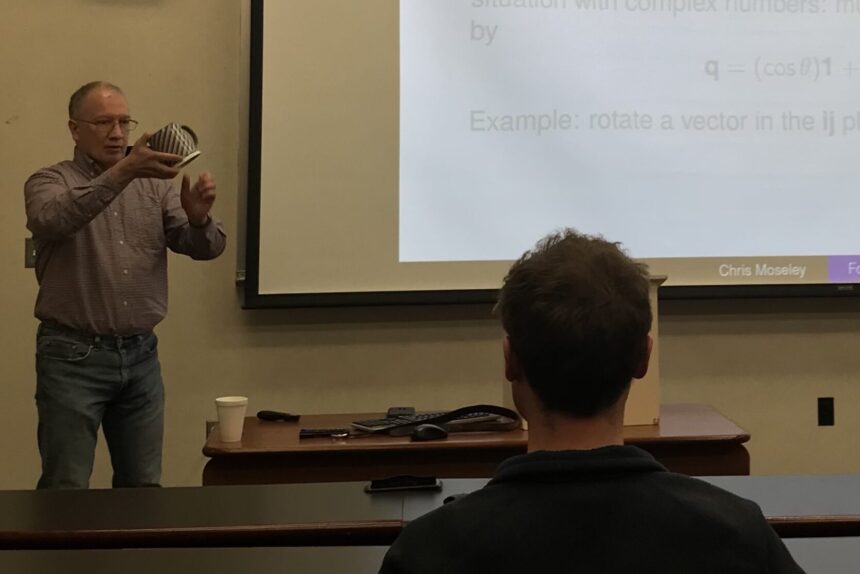Christopher Moseley of Calvin College spoke about four-dimensional numbers. Sophia Mandt | Collegian
The discovery of four-dimensional numbers opened a window in the mathematical world according to Christopher Moseley, an associate professor at Calvin College.
Moseley spoke about four-dimensional numbers on March 19 for the 2024 Math Colloquium presented by the mathematics department.
Moseley said that mathematician William Hamilton came up with the concept of four-dimensional numbers in 1843.
“A lot of people think that the fourth dimension is time because of Einstein’s theory of relativity,” Moseley said. “But when Hamilton came up with four-dimensional numbers called quaternions, he was thinking about a fourth dimension of space.”
Moseley said that quaternions are different from real numbers. Real numbers are one-dimensional — either positive or negative on a number line. Complex numbers can represent two dimensions by combining real numbers found on the horizontal axis with imaginary numbers found on the vertical axis.
According to Moseley, Hamilton tried to come up with a three-dimensional number, but it was impossible to do based on the properties mathematicians are used to.
Junior Parker Reed said the algebra Hamilton wanted to perform would have implied that two non-zero values multiplied together would equal zero. But this didn’t work.
“His solution was to disregard something called commutativity, meaning the order in which the numbers are multiplied matters for the product,” Reed said. “In the case of quaternions, he decided that ij=-ji, which was considered controversial at a time when abstract algebra didn’t exist.”
Reed said that quaternions are connected with the development of scalars and vectors. Scalars are quantities that have only a magnitude, like “four miles,” while vectors are numbers that have both direction and magnitude, like “four miles west.”
Reed said that when Hamilton was describing his work, he noticed that his quaternion number could be broken down into a scalar component and a vector component. No matter what linear combination of values he used, every term was uniquely described.
“That’s very hard to visualize but you can think of it as a+bi+cj+dk,” Moseley said. “They’re like complex numbers except now the i, the j and the k all square to be -1.”
Moseley said that Hamilton’s system allowed mathematicians to start thinking about different number systems.
Moseley said quaternions are used in spacecraft attitude control, computer graphics, and game engines because they are a more efficient use of computer memory.
He also said that the field of quantum mechanics relies on quaternions.
Junior Zach Adam said he enjoyed the colloquium.
“I found it interesting that the search for triple numbers ended up with the discovery of quaternions because sometimes we look at mathematicians in the 19th century and think ‘oh this is kind of pointless, it doesn’t actually describe our world,’” Adam said. “And then later we discover that it actually fits perfectly within our world.”
Moseley said the discovery of four-dimensional numbers has enabled mathematicians to explore even farther.
“It allowed mathematicians to think, ‘I’m not confined to this world of real numbers. There’s other things out there. Let’s find them,’” Moseley said.
![]()

